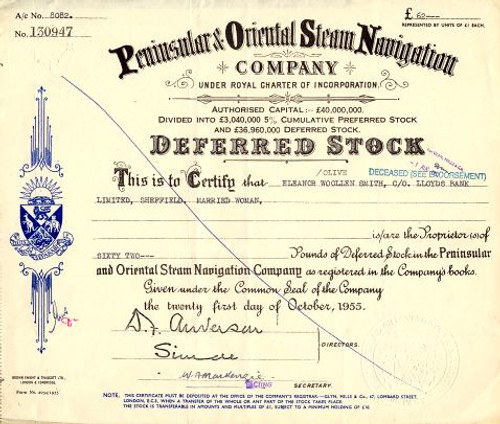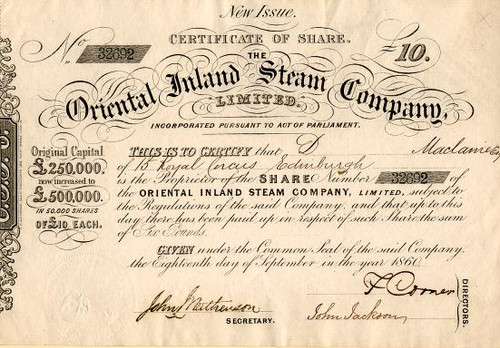Beautifully engraved certificate from the Peninsular and Oriental Steam Navigation Company issued in 1987. This historic document has a vignette of the company's logo and an old sailing ship. There is also an embossed corporate seal. This item is over 18 years old. 
Certificate Vignette The Peninsular and Oriental Steam Navigation Company, which is usually known as P&O, is a British shipping and logistics company which dates from the early 19th century. It is listed on the London Stock Exchange and is a constituent of the FTSE 250 Index. Its head office is in London. In 1822 Brodie McGhie Wilcox and Arthur Anderson went into partnership to operate a shipping line, primarily operating routes between England and Spain and Portugal. In 1835 a Dublin shipowner named Captain Richard Bourne joined the business and the three men started a regular steamer service between London and Spain and Portugal - the Iberian Peninsula - using the name Peninsular Steam Navigation Company, with services to Vigo, Oporto, Lisbon and Cadiz. In 1837 the business won a contract from the British Admiralty to deliver mail to the Iberian Peninsula and in 1840 they acquired a contract to deliver mail to Alexandria in Egypt. The present company, the Peninsular and Oriental Steam Navigation Company was incorporated in that year by a Royal Charter, and its name therefore includes neither "Plc" nor "Limited". Mail contracts were to be the basis of P&O's prosperity until the Second World War, but the company also became a major commercial shipping line and passenger liner operator. In 1914 it took over the British India Steam Navigation Company, which was then the largest British shipping line, owning 131 steamers. Further acquisitions followed and the fleet reached a peak of almost 500 ships in the mid 1920s. 85 of the companies ships were sunk in the First World War and 179 in the Second World War. After 1945 the passenger market declined. P&O entered the cruise market, but it concentrated mainly on cargo ships. It entered the tanker trade in 1959 and the roll-on roll-off ferry business in the mid 1960s. It was also a pioneer of container shipping, and by the early 1980s it had converted all of its dry cargo liner routes to container operations. Over the last quarter of the Twentieth Century P&O also diversified into construction management (through the Bovis companies, which it owned from 1974 to 1999), property investment and development, and a variety of service businesses including exhibition and conference centres, but most of these activities were disposed of following the company's decision in March 1999 to concentrate on its maritime and transport interests. Its P&O Ports and P&O Cold Logistics divisions both developed from P&O's operations in Australia, where it has a leading position in both of these fields. On 23 October 2000 P&O demerged its cruise business P&O Princess Cruises plc. In April 2003 P&O Princess came together with the Carnival Corporation to form Carnival Corporation & Plc. In June 2005 the board of Royal P&O Nedlloyd, a major container shipping business into which P&O had merged its own container operations in and in which it holds a 25% stake, recommended a takeover offer from A.P. Moller-Maersk Group. The operating profit for 2004 was £268.3 million.

Certificate Vignette








